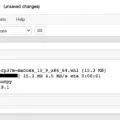Are you looking for a powerful, interactive computing environment for your Mac? If so, then the Jupyter Notebook is just what you need!
The Jupyter Notebook is a web-based application that enables users to create and share documents that contain live code, equations, visualizations, and narrative text. It’s an ideal tool for data scientists, educators, and researchers who want to analyze and document their workflows.
Installing the Jupyter Notebook on Mac is straightforward. First, you need to download Python 3 from the official website. Once it’s downloaded, open the Terminal app and type “python3” to check if Python 3 is installed correctly. Then upgrade pip with the command “pip3 install –upgrade pip”. Finally, enter “pip3 install jupyter” in Terminal to install the Jupyter Notebook on your Mac.
Once installation is complete, launch the Jupyter Notebook app by typing “jupyter notebook” in the Terminal. This will open up a new web browser window where you can create and share documents with live code and visualizations. You can also export documents as PDF files or HTML files for sharing with colleagues or students.
The Jupyter Notebook makes it easy to explore data interactively in an intuitive environment. With its rich set of features and ease of use, it’s no wonder why so many people are using this powerful tool for data analysis on their Macs!

Downloading Jupyter Notebook on Mac
To download Jupyter Notebook on Mac, you’ll need to first install the latest version of Python3. You can do this by going to the Python website and downloading and running the installer package for your version of MacOS. Once that’s done, you’ll need to check if pip3 and python3 have been correctly installed by opening up a terminal window and entering “pip3 –version” and “python3 –version” respectively.
Next, you’ll want to upgrade your pip version to avoid any errors during installation. To do this, simply enter “sudo pip3 install –upgrade pip” into your terminal window. Finally, you can install Jupyter Notebook using pip3 by entering “pip3 install jupyter” into your terminal window. After installation, you can launch Jupyter Notebook from the command line with the “jupyter notebook” command.
Using Jupyter on a Mac Computer
Yes, there is a Jupyter app available for Mac. The app is compatible with macOS 10.9 and higher and can be downloaded as a one-click installer directly from the project’s GitHub page. Once installed, the app will provide you with an integrated development environment to create and run Jupyter Notebooks. It also comes with advanced features like support for multiple languages, custom keyboard shortcuts, customizable themes, and other plugins to extend its functionality.
Installing Anaconda Jupyter Notebook on Mac
Installing Anaconda Jupyter Notebook on a Mac is a simple process. First, download the graphical macOS installer for your version of Python from the Anaconda website. After downloading, double-click the file and click Continue to start the installation. On the Introduction, Read Me, and License screens, answer the prompts as needed. When prompted to select an install location, choose either to install it for all users or on a specific disk.
Next, open a terminal window and enter “bash Anaconda3-” followed by your version number to begin the installation process. The installer will prompt you with several questions regarding how you want to install Anaconda Jupyter Notebook. Once you have answered these questions and accepted the license agreement, the installation will commence.
When complete, you can open a new terminal window and enter “jupyter notebook” to launch Jupyter Notebook from within an environment that has access to all packages installed with Anaconda. If you encounter any errors during this process, consult the official Anaconda documentation for help troubleshooting specific issues related to your particular setup or OS version.
Installing Jupyter Notebook Without Anaconda
Yes, you can install Jupyter Notebook without Anaconda. All you need to do is use pip to install the jupyter package. You can type in “pip install jupyter[all]” into your terminal or command line and the package will be installed into your Python environment. Once the installation is complete, you will be able to launch Jupyter Notebook from any directory. Additionally, if you have an existing Python environment, Jupyter Notebook will work with that as well. With Jupyter Notebook, you can explore and analyze data interactively and create beautiful visualizations.
Running Python Jupyter Notebooks on Mac
To run a Python Jupyter Notebook on Mac, you first need to open the terminal application. To do this, navigate to Applications > Utilities > Terminal. Once the terminal app opens, navigate to the desired folder using the cd command. Once you are in the desired folder, type jupyter notebook and press Enter. This will start the Jupyter server and open a new browser window or tab with a list of files in the current directory. You can click on any file that has an .ipynb extension to open it as a notebook. Alternatively, you can create a new notebook by clicking on New > Python 3 from the top right corner of the page. After making your edits, save your changes by clicking on File > Save or pressing Command + S.

Source: blog.roboflow.com
Installing Python on a Mac
Installing Python on a Mac is an easy process. The first step is to download the official installer package from Python’s website. Once the download has been completed, open the installer package and follow the instructions that appear on your screen. Depending on your system configuration, you may need to enter your password to continue with the installation. Once all of the necessary information has been entered, the installation will begin.
Once the installation is complete, you can access Python by opening a terminal window and typing “python” into it. If you are using a version of Mac OS X older than 10.8 (Mountain Lion), you may need to install additional software such as Xcode or Homebrew in order to install Python correctly. If this is the case, simply follow the instructions provided by either program during setup and then proceed with installing Python as usual.
In conclusion, installing Python on a Mac is easy and straightforward if you have all of the necessary prerequisites already installed on your computer. It should only take a few minutes for you to be up and running with Python!
Using Anaconda on Mac
Yes, you can use Anaconda on Mac. Anaconda is a powerful package manager, environment manager, and Python distribution that contains a collection of many open-source packages. It is available for Windows, MacOS, and Linux operating systems. To install Anaconda on your Mac, download the Anaconda installer from the official website and follow the instructions given in the installer. Once installed, you can use the Anaconda Navigator to manage your environments and packages. You can also use the Conda command line tool to manage environments and packages. With Anaconda installed on your Mac, you will have access to a wide range of open-source packages that are useful for data science and machine learning tasks.
Conclusion
In conclusion, Jupyter Notebook is an incredibly powerful and versatile tool for data analysis and scientific computing on MacOS. It is easy to install with one-click installers that are available for each platform and can be downloaded from the project’s GitHub page. It also features a graphical macOS installer for different versions of Python. With its interactive coding environment, users can easily execute code, debug programs, and create visualizations all within the same interface. All in all, Jupyter Notebook provides a great way to analyze data and develop scientific applications quickly and efficiently on MacOS.








